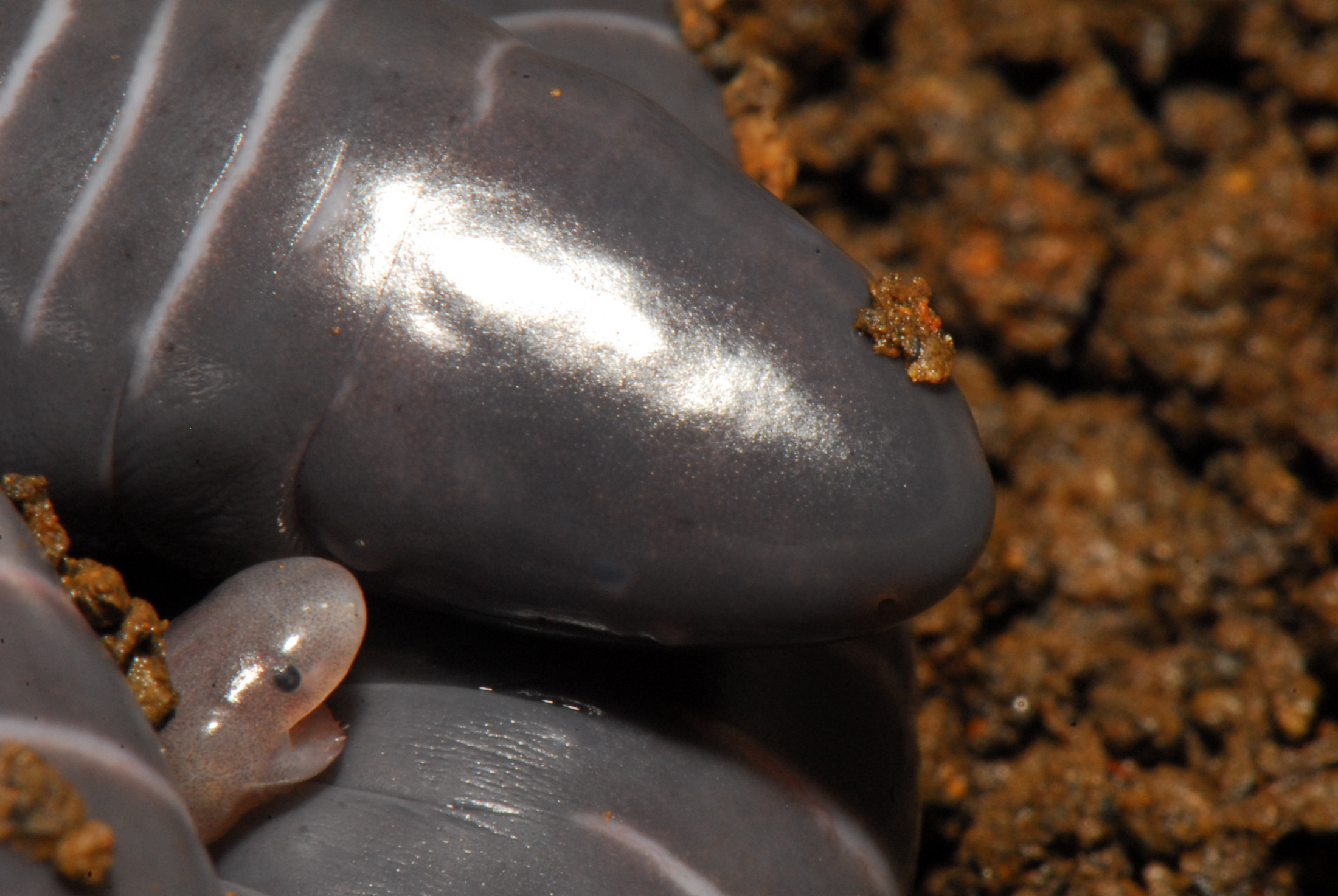Caecilians are an elusive type of amphibian that primarily live underground and look like a cross between a worm and a snake. One of the few things that is known about caecilians is their unique method for feeding their young. Mothers produce a special layer of fatty skin tissue, which juvenile caecilians tear off with baby teeth that evolved specifically for that purpose.
A new study shows that skin-feeding does more than provide nutrients for young caecilians. It also helps the mother pass microbes from her skin and gut down to her young, inoculating them to jump-start a healthy microbiome. This is the first direct evidence that parental care in an amphibian plays a role in passing microbes from one generation to the next.
“There’s still a remarkable amount of caecilian biology that we just don’t know anything about, mostly because they can be hard to find,” said David Blackburn, the Florida Museum’s curator of herpetology. “To our knowledge, this is the first published study of a caecilian microbiome.”

Photo Courtesy of Carlos Jared
Across the animal kingdom, there are many different strategies for parental care. Human mothers give their babies breastmilk, emperor penguins regurgitate food for their chicks and female koalas feed their young a special form of feces.
Among amphibians, caecilians are unique for feeding their young at all. Previous efforts to understand amphibian microbiomes focused on frogs and salamanders, the more well-known orders of the Amphibia class. Those studies, however, came back inconclusive largely because there are few frog and salamander species that care for their young after they’re born or hatched — most simply lay eggs and leave juveniles to develop on their own.
Not so with caecilians.
“When you find the eggs, you always find the mother,” said Marcel Talla Kouete, first author of the study and a doctoral candidate in the University of Florida School of Natural Resources and Environment. “I’ve never seen a juvenile without an attending mother.”
Kouete said this is why he became fascinated by caecilians as he began working on them. Since this parenting behavior first came to light in 2006, scientists have noticed that even once skin-feeding ends, mother and babies stay together, with the former coiling her body around the latter. Kouete wondered whether the behavior served another function in addition to providing nutrients, reasoning that there was likely some transfer of the microbes from the surface of the mother’s skin, similar to bacterial transmission in other animals.
In humans, microbes move onto the skin as babies pass through the mother’s birth canal and into the body via breastmilk. These microbes help keep the human body alive and well, forming a microscopic community known as the microbiome, and perform essential tasks like breaking down complex carbohydrates, training the immune system and producing vitamins. A growing body of research seeks to better understand the relationship between disease and microbiome health.
Kouete and his colleagues focused their research on Herpele squalostoma, a caecilian species from central Africa that participates in skin-feeding behavior. They took samples from the environment as well as the skin and guts of 14 juveniles, nine female adults and six male adults. They then sequenced the bacteria colonies of each.
The researchers found that every juvenile shared some part of their skin and gut microbiome with their attending mother. This transfer happens both when the mother coils around the young, engaging in skin-to-skin contact, and when the juveniles eat the mother’s skin.
Samples taken from the surrounding soil, water and leaves showed that the immediate environment was the least important source for juvenile microbiomes.

Photo by Kouete et al. (2023), CC-BY
In addition to shedding light on caecilian biology, Kouete’s paper contributes to the neglected research topic of African microbes. Despite the great genetic diversity on the African continent, microbiome research thus far has primarily focused on the Global North.
Until recently, caecilians have rarely been studied, in part, because they are native to the tropical regions of the Americas, Africa and Southeast Asia, where there has been a limited scientific presence. The H. squalostoma specimens used in the study were sampled in Cameroon, where Kouete is from.
For future investigation, the research team is curious about how microbiomes benefit caecilians and contribute to their health. “Is there an evolutionary advantage? If so, are these benefits absent when parental care is circumvented?” Kouete asked. This paper lays the groundwork for future studies by identifying some of the microbes present.
“This study is a bit like going out into the world and figuring out all the frogs that live in a forest,” Blackburn said. “We might find ground frogs, tree frogs and burrowing frogs; big species and small; ones that breed in this way or that way. Based on those characteristics, you could start inferring what role they play in the forest ecosystem, which is what we’d like to do with the caecilian microbiome.”
Funding was provided in part by the University of Florida and National Science Foundation (Grant nos. NSF 1556559, NSF 1560667 and IOS-1845634).
Molly Bletz, Brandon LaBumbard and Douglas Woodhams of the University of Massachusetts Boston are also authors on the paper.
Sources: Marcel Kouete, tallakmarcelk@gmail.com;
David Blackburn, dblackburn@flmnh.ufl.edu
Writer: Jiayu Liang, jiayu.liang@floridamuseum.ufl.edu, 352-294-0452